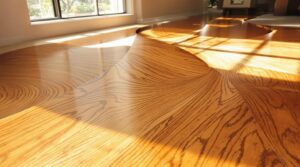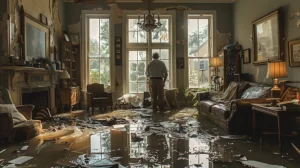Water leak detection under concrete slabs requires systematic evaluation through visual indicators and advanced technologies. Key signs include unexplained water bill increases, localized hot spots on flooring, and audible water movement during non-usage periods. Professional detection methods employ ground penetrating radar (GPR), thermal imaging, and acoustic sensors for precise leak identification. Early intervention utilizing these diagnostic approaches prevents extensive structural damage and elevated utility costs. Further exploration reveals thorough detection strategies and cost-effective solutions. Effective strategies not only identify the presence of leaks but also offer guidance on maintenance and prevention techniques for the future. If you’re wondering how to detect concrete floor leaks, employing these advanced technologies alongside routine checks can significantly mitigate potential issues before they escalate. Additionally, consulting with professionals experienced in leak detection can provide tailored recommendations suited to your specific property needs.
Key Takeaways
- Monitor unexplained increases in water bills, persistent hot spots on floors, or sounds of running water when fixtures aren't in use.
- Use professional leak detection equipment like thermal imaging cameras and acoustic sensors to pinpoint exact leak locations non-invasively.
- Look for visible signs including moisture under floor coverings, foundation cracks, or unusual dampness around the building's perimeter.
- Employ ground penetrating radar (GPR) technology to create detailed subsurface imagery of water leaks without damaging the concrete.
- Check water meter readings when all fixtures are off; movement indicates a potential leak requiring professional investigation.
Understanding the Signs of a Slab Leak
Water infiltration beneath concrete foundations manifests through multiple diagnostic indicators that property owners and professionals can systematically evaluate.
Primary slab leak causes include compromised plumbing infrastructure, resulting in observable phenomena such as unexplained increases in water utility costs and audible water movement during periods of non-usage. Specialized acoustic listening devices amplify sounds of water escaping from damaged pipes to assist in locating leaks.
Professional plumbing maintenance protocols emphasize the identification of characteristic markers, including moisture accumulation beneath floor coverings, activation of water meter mechanisms during system dormancy, and peripheral water pooling.
Secondary manifestations frequently present as structural anomalies, including fracturing of baseboards, elevated floor temperatures, microbial growth accompanied by distinctive odors, and deformation of wood flooring materials.
The presence of these indicators necessitates immediate investigation utilizing specialized detection equipment to prevent extensive structural deterioration and water damage.
Early Warning Signs You Shouldn't Ignore

Vigilant monitoring of foundation integrity requires recognition of specific diagnostic indicators that signal subsurface plumbing failures.
Early detection protocols emphasize identification of diminished water pressure localized to specific areas adjacent to the concrete slab foundation. Thermal anomalies manifesting as persistent hot spots on flooring surfaces frequently indicate compromised hot water lines beneath the structure.
Critical indicators warranting immediate assessment include structural fissures in exterior walls, particularly at stress points near fenestrations and wall-ceiling junctions. The presence of musty mold odors throughout living spaces often reveals hidden moisture problems requiring professional evaluation.
Leak prevention strategies must address auditory indicators such as unexplained water movement sounds when plumbing fixtures are inactive. Additionally, the presence of moisture-related discoloration, dampness patterns, or unusual staining on floor surfaces necessitates prompt investigation to prevent extensive foundation damage and subsequent structural deterioration.
Visual Inspection Methods for Homeowners
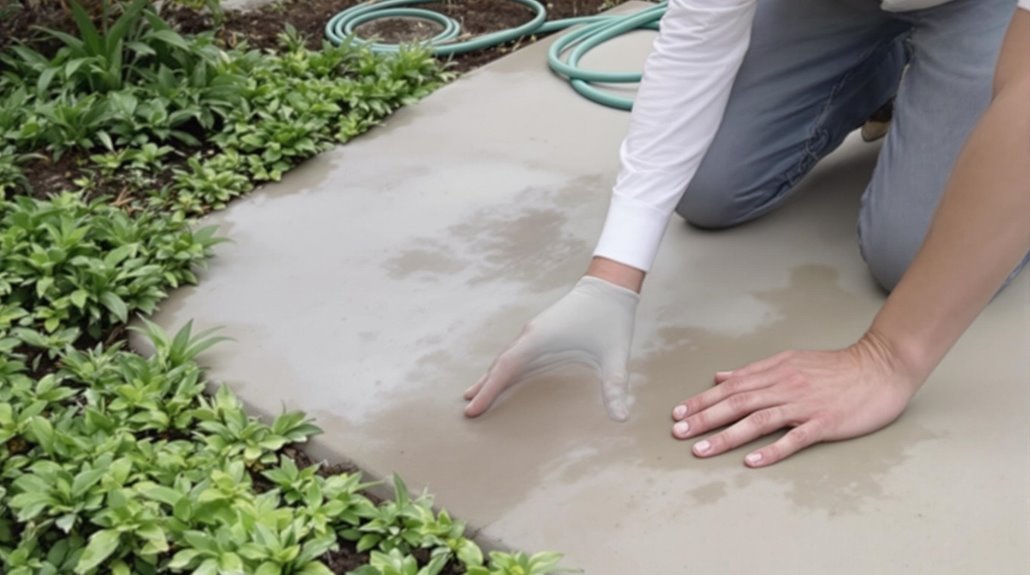
Systematic visual assessment protocols enable homeowners to detect subsurface plumbing failures through methodical exterior and interior inspection procedures. The thorough homeowner checklist encompasses examination of ground conditions, structural elements, and plumbing infrastructure. Unexplained spikes in monthly water bills can provide early warning signs of hidden slab leaks.
Visual inspection methodologies focus on identifying moisture-related anomalies, structural deviations, and performance irregularities that indicate subsurface water leakage.
- Monitor exterior landscaping for abnormal vegetation growth patterns and soil saturation indicators
- Evaluate interior flooring components for moisture-induced deterioration and discoloration
- Assess exposed plumbing systems for corrosion, mineral deposits, and joint integrity
Implementation of these visual inspection protocols allows for early detection of slab leaks through observation of characteristic manifestations.
Professional assessment is recommended when visual indicators suggest potential subsurface plumbing compromise, as early intervention minimizes structural damage and restoration costs.
Advanced Detection Technologies and Tools
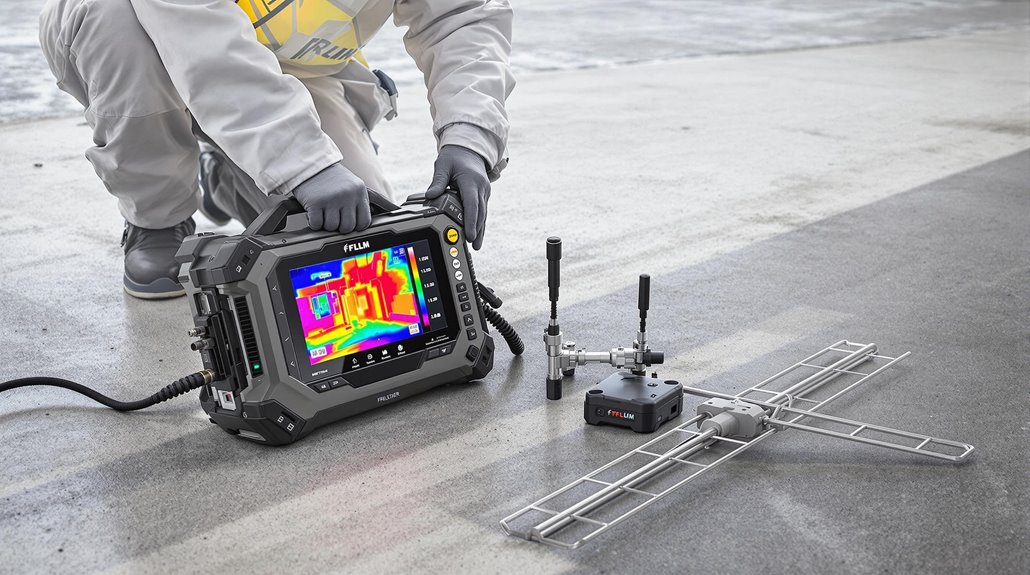
Advanced leak detection systems employ multiple integrated technologies to identify subsurface water intrusion beneath concrete slabs.
Digital sensors combine thermal imaging solutions that detect temperature variations with ground penetrating radar to map subsurface anomalies indicating water presence.
These sophisticated tools enable technicians to precisely locate compromised plumbing infrastructure without invasive exploration of the concrete substrate.
Digital Leak Detection Systems
Digital leak detection systems represent cutting-edge technology in modern plumbing diagnostics, incorporating both electronic and acoustic methodologies for precise leak identification beneath concrete slabs.
These systems utilize sophisticated digital monitoring equipment, combining high-voltage electronic detection (HVELD) and low-voltage electronic detection (LVELD) technologies with advanced acoustic sensors for thorough analysis.
- Integrated digital systems featuring stabilized DC output voltage detection capabilities
- Advanced acoustic sensors with user-selectable frequency filtration
- Real-time data processing with pinpoint accuracy for subsurface leak location
Modern digital detection equipment incorporates specialized tools like the Aquaphon A200 and Stethophon 04, which provide precise sound reproduction and noise filtering capabilities.
These systems can detect microscopic breaches through electronic scanning while simultaneously monitoring acoustic signatures, offering unparalleled accuracy in identifying water leaks beneath concrete foundations.
Thermal Imaging Solutions
Building upon electronic detection methods, thermal imaging technology offers a sophisticated approach to identifying subsurface water leaks through temperature differential analysis.
High-resolution thermal cameras, such as the FLIR E8 and T-Series models, utilize Multi-Spectral Dynamic Imaging Technology (MSX) to combine thermal and visible imagery for enhanced detection capabilities.
The principle operates on visualizing temperature variations caused by water evaporation, where ground water leaks typically present as cooler anomalies compared to surrounding areas.
This technology proves particularly effective when inspecting radiant heating systems, where temperature differentials between supply and return lines indicate system performance and potential leaks.
For best results, thermal imaging equipment must feature high thermal sensitivity and adjustable level and span controls, allowing technicians to precisely locate temperature inconsistencies that signal the presence of subsurface water infiltration.
Ground Penetrating Radar
Ground Penetrating Radar (GPR) technology represents a sophisticated non-destructive testing method for identifying subsurface water leaks beneath concrete slabs.
GPR applications utilize electromagnetic pulses to create detailed subsurface imagery, enabling technicians to locate pipes and detect water saturation anomalies. Professional GPR training is essential for accurate data interpretation and equipment operation.
- GPR accuracy depends on proper calibration considering soil dielectric properties and environmental conditions.
- GPR equipment requires vertical antenna positioning parallel to suspected leak areas for ideal scanning.
- GPR analysis software processes collected data to generate 2D or 3D subsurface visualizations.
GPR versatility extends beyond leak detection to various fields, including engineering and geology.
While GPR technology offers precise leak location capabilities, its effectiveness relies on proper site preparation, professional expertise, and integration with complementary detection methods for result verification.
Professional Leak Detection Services
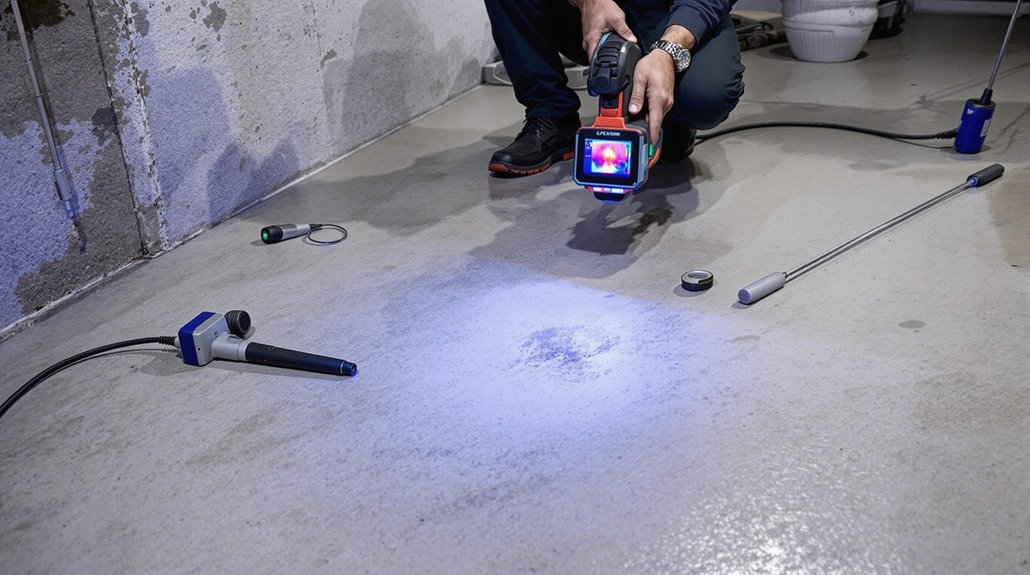
Professional leak detection services employ sophisticated diagnostic equipment like thermal imaging cameras, acoustic sensors, and ground microphones to precisely locate water leaks beneath concrete slabs.
These advanced technologies enable technicians to identify leak locations without destructive exploration, greatly reducing repair costs and structural damage.
Early professional intervention utilizing specialized detection methods can prevent extensive water damage, foundation issues, and escalating utility expenses that often result from undetected slab leaks.
Expert Equipment Benefits
Advanced diagnostic equipment utilized by leak detection specialists offers superior accuracy and efficiency in identifying subsurface water leaks.
Professional technicians employ sophisticated tools like thermal imaging cameras, acoustic detectors, and pressure sensors to achieve maximal leak accuracy. These advanced tools enable precise location identification without extensive excavation of concrete surfaces.
- DeckPlate and Pipe Probe technology detects leaks through solid surfaces with minimal intrusion
- Thermal imaging cameras identify temperature variations indicating subsurface water presence
- Advanced listening devices pinpoint exact leak locations by detecting specific acoustic signatures
The integration of multiple detection methods, including moisture readers and pressure monitoring systems, provides thorough diagnostic capabilities.
This systematic approach, combined with certified expertise, guarantees reliable identification of water leaks beneath concrete slabs while minimizing property disruption and repair costs.
Cost-Effective Early Detection
While expert equipment provides superior diagnostic capabilities, early detection through professional services proves to be the most cost-effective approach for managing slab leaks.
Initial detection services, ranging from $150 to $400, utilize advanced leak detection technology to identify issues before they escalate into costly structural damage.
Professional detection services employ non-invasive methods, including acoustic sensors and thermal imaging, to precisely locate leaks without extensive excavation.
These cost-effective solutions become particularly valuable when considering key indicators such as unexplained water bill increases, pressure drops, or moisture spots.
By addressing these signs promptly through professional assessment, property owners can prevent extensive water damage, avoid foundation settling, and mitigate potential mold growth.
This proactive approach notably reduces long-term repair expenses and structural rehabilitation costs.
Cost Implications of Slab Leak Detection

Detecting water leaks beneath concrete slabs involves several cost variables that property owners must consider. Professional detection methods range from $150 to $400, encompassing acoustic listening devices, infrared cameras, and pipe inspection technology.
The cost efficiency of early detection greatly impacts overall expenses, as delayed response can escalate repair costs considerably.
Key cost factors include:
- Initial detection services ($150-$400) utilizing specialized equipment
- Repair costs varying from $630 to $4,400 based on leak severity
- Additional concrete foundation repairs ranging from $300 to $6,750
The total investment depends on leak accessibility, detection method employed, and necessary repairs.
Advanced detection techniques like noise correlating systems may increase initial costs but often provide more precise diagnostics, potentially reducing overall repair expenses.
Emergency services typically command premium rates, making scheduled inspections more economical.
Prevention and Maintenance Strategies
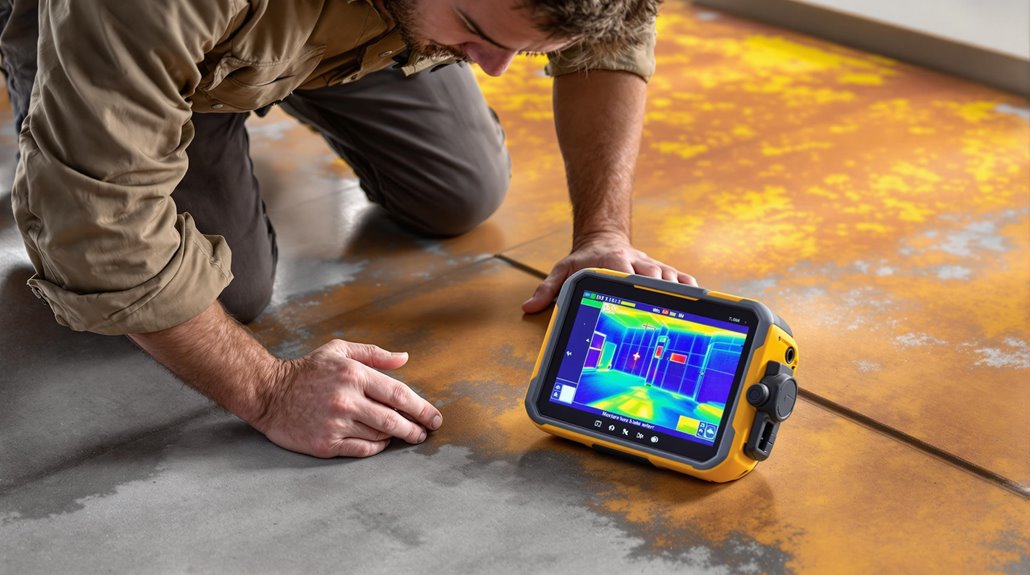
Implementing thorough preventive maintenance strategies is essential for maintaining the structural integrity of concrete slabs and mitigating potential water intrusion issues. Key preventive measures include utilizing appropriate waterproofing systems, conducting regular relative humidity testing, and maintaining functional vapor retarders.
Critical maintenance tips emphasize the importance of systematic monitoring through moisture meters and infrared cameras to detect anomalies before they escalate into significant problems.
Property managers should implement an extensive inspection protocol that includes regular assessment of waterproofing membranes, whether torch-on, liquid, or cementitious systems. The protocol should encompass periodic examination of the slab for signs of moisture intrusion, such as discoloration or dampness, and prompt sealing of any identified cracks.
Professional leak detection services may be employed for thorough evaluations using advanced technologies.
When to Call a Professional Plumber
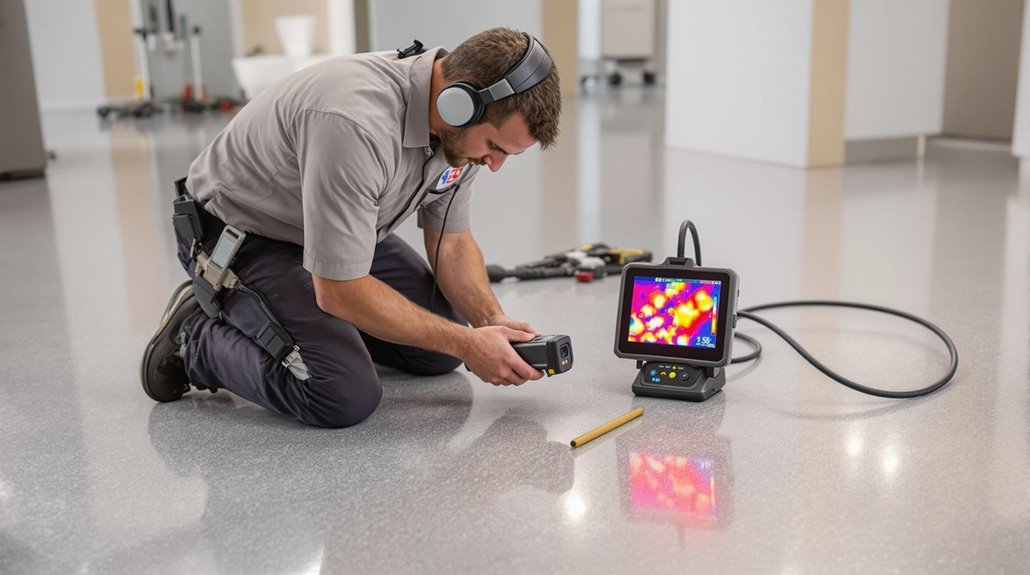
Recognizing the appropriate time to engage a professional plumber becomes essential when dealing with under-slab water leaks, as these issues often require specialized expertise and equipment for accurate diagnosis and repair.
While slab leak prevention and routine plumbing maintenance can mitigate risks, certain indicators necessitate immediate professional intervention.
- Unexplained increases in water consumption coupled with elevated meter readings despite normal usage patterns
- Visible manifestations of moisture intrusion, including foundation cracks, floor dampness, or persistent musty odors
- Acoustic anomalies such as running water sounds when fixtures aren't in use
Professional plumbers employ advanced detection methodologies, including thermal imaging, pressure testing, and acoustic detection equipment, to precisely locate and assess under-slab leaks.
This technical expertise guarantees accurate diagnosis and appropriate remediation strategies, preventing extensive structural damage and maintaining property integrity.
The Benefits Of Consulting A Public Adjuster
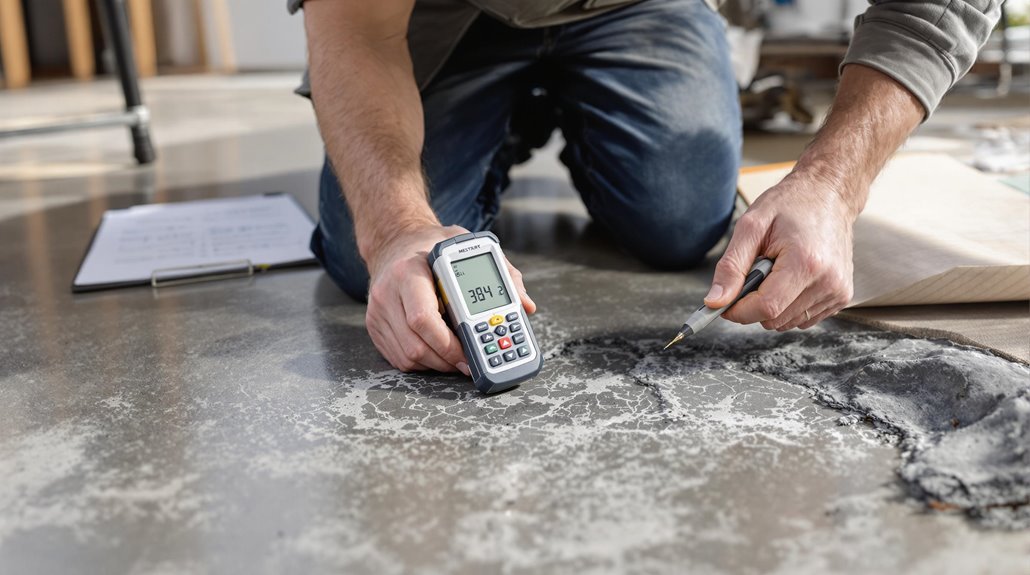
When dealing with water damage beneath concrete slabs, consulting a public adjuster provides essential expertise in managing complex insurance claims and ensuring thorough coverage assessment.
Public adjusters conduct independent, objective evaluations of structural damage while documenting all direct and consequential losses according to industry standards.
Through their specialized knowledge and negotiation capabilities, public adjusters typically secure higher settlement amounts while streamlining the claims process for property owners.
Studies have shown that property owners who work with licensed public adjusters receive settlements up to 500% higher for non-catastrophic claims compared to handling claims themselves.
Expertise In Insurance Claims
Due to the complex nature of water leak insurance claims under concrete slabs, consulting a public adjuster can greatly improve claim outcomes and settlement values. Their expertise in insurance claim strategies provides detailed damage assessment and maximized settlement potential, with studies demonstrating considerably higher payouts compared to policyholder-managed claims.
Public adjusters leverage their specialized knowledge to guarantee all damages are properly documented and valued.
- Professional evaluation of water damage scope, including hidden deterioration beneath concrete
- Strategic negotiation with insurance carriers to optimize claim settlements
- Expert documentation and valuation of both direct and consequential damages
These licensed professionals work exclusively for policyholders, providing dedicated representation throughout the claims process.
Their thorough understanding of policy provisions and coverage parameters enables them to identify and include all compensable damages, leading to more favorable settlement outcomes.
Operating on a contingency fee basis, public adjusters typically charge between 5-20% of the final settlement amount, making their services accessible to most policyholders.
Objective Damage Assessment
Professional damage assessment through a public adjuster provides an unbiased, systematic evaluation of water-related destruction beneath concrete slabs. Utilizing advanced leak detection equipment, including moisture meters and thermal imaging technology, adjusters conduct thorough examinations to identify both visible and concealed damage patterns.
The assessment process incorporates specialized documentation protocols, capturing detailed evidence of structural compromise, moisture infiltration, and potential secondary damages.
Public adjusters employ industry-standard estimation software to calculate precise repair costs while evaluating the necessity for professional restoration services. Their objective analysis includes thorough examination of affected personal property, fixtures, and potential long-term implications such as mold proliferation.
This methodical approach guarantees accurate damage quantification, supporting extensive insurance claims and appropriate compensation for necessary repairs and remediation procedures.
With licensed public adjusters operating across 40+ states, property owners can access expert claim assistance for water damage regardless of their location.
Streamlined Claim Process
Engaging a public adjuster considerably enhances the efficiency and effectiveness of water damage claims beneath concrete slabs. Their expertise in leak detection and insurance implications streamlines the complex documentation process while guaranteeing thorough coverage for structural damages.
Public adjusters expedite claim resolution through systematic damage assessment and professional negotiations with insurance carriers.
- Manages intricate documentation requirements for subsurface water damage detection and repair
- Coordinates with leak detection specialists to establish clear causation evidence
- Navigates complex policy provisions specific to concrete slab water damage claims
The adjuster's involvement eliminates policyholder stress by handling all communications with insurance representatives, while their contingency-based compensation structure aligns with the client's interests.
Their professional knowledge of industry standards and regulatory requirements guarantees proper claim valuation and timely settlements, particularly vital in cases involving progressive water damage beneath concrete foundations.
Unlike insurance adjusters who work for carriers, public adjuster fees are typically capped at 10% of the total claim settlement, ensuring fair representation focused on maximizing policyholder recovery.
Higher Claim Payouts & Settlements
When homeowners secure the services of licensed public adjusters for concrete slab water damage claims, statistical data demonstrates markedly higher settlement outcomes compared to self-managed claims.
Professional adjusters leverage their extensive understanding of insurance policies and claim negotiation protocols to maximize settlements for water-related structural damage.
Studies conducted by insurance industry associations reveal that professionally adjusted claims typically result in settlements approximately 19% higher than those handled independently.
Public adjusters systematically document all damages, including secondary effects of water infiltration beneath concrete slabs, ensuring thorough claim documentation.
Their expertise in policy interpretation and industry-standard assessment methodologies enables precise damage evaluation and superior settlement negotiations.
Operating on contingency fees, these licensed professionals provide expert representation without requiring upfront costs, while maintaining objectivity throughout the claims process.
Insurance claims adjusters must maintain state-specific licenses and complete ongoing education requirements to ensure compliance and accurate claim assessments.
About The Public Claims Adjusters Network (PCAN)
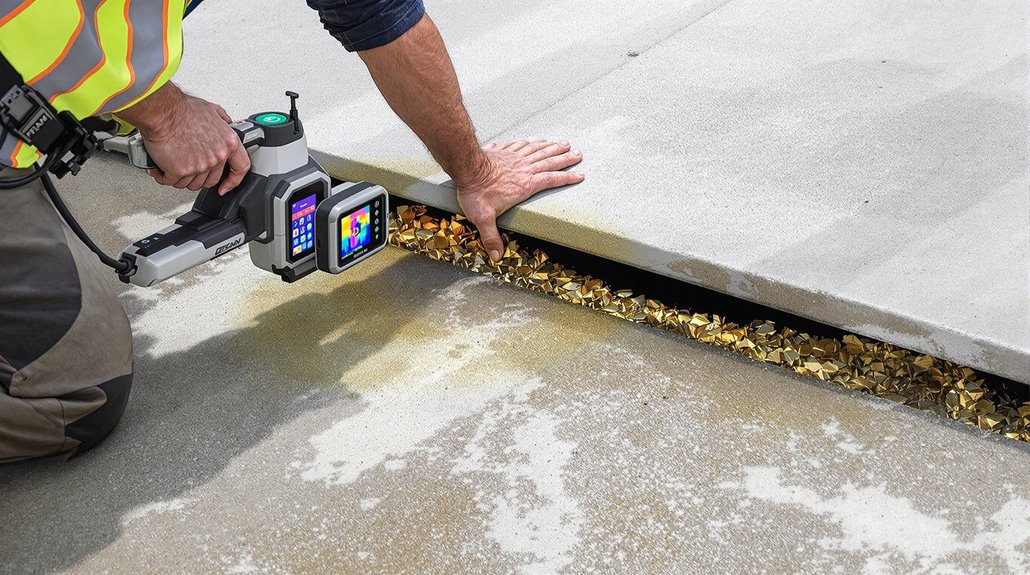
The Public Claims Adjusters Network (PCAN) functions as a nationwide organization specializing in exhaustive insurance claims management and policyholder advocacy. Operating across all 50 states with international offices, PCAN delivers extensive claims advocacy services through experienced adjusters who excel in policy interpretation and damage assessment protocols.
- Licensed professionals handle complete claim documentation and submission processes
- Dedicated call centers guarantee immediate response and seamless communication
- Expert teams calculate business interruption costs and property value depreciation
PCAN's independent adjusters work exclusively for policyholders' interests, managing claims from initial notice of loss through final settlement.
The organization leverages industry-leading expertise to navigate complex insurance claims, providing customized solutions for both residential and commercial clients.
Their network of seasoned adjusters guarantees adaptability and specialized knowledge for routine and catastrophic events.
Frequently Asked Questions
How Long Does a Professional Slab Leak Detection Typically Take?
Ironically, while water moves swiftly, professional leak detection beneath slabs requires meticulous analysis, typically spanning 1-4 hours depending on detection methodology, repair techniques, and structural complexity.
Can Homeowners Insurance Cover the Cost of Slab Leak Repairs?
Homeowners insurance coverage typically applies to slab leak repair costs when caused by sudden, accidental events but excludes gradual damage. Standard policies cover water damage remediation while requiring additional endorsements for pipe repairs.
Is It Possible to Waterproof a Concrete Slab After Repair?
Following successful repairs at a commercial warehouse, concrete slabs can be effectively waterproofed using various waterproofing methods, including penetrating sealers, cementitious coatings, and impermeable concrete sealants applied under controlled environmental conditions.
What's the Average Lifespan of Pipes Underneath a Concrete Slab?
Underground plumbing lifespan varies by pipe material: Type-K copper sustains 100+ years, Type-L copper 50+ years, Type-M copper 5-20 years, while concrete and reinforced concrete pipes maintain 100+ years longevity.
Can Tree Roots Cause Slab Leaks and How Can This Be Prevented?
Tree root intrusion penetrates underground pipes through microscopic fissures, causing devastating slab leaks. Prevention requires strategic plumbing maintenance, installation of root barriers, and maintaining proper distance between vegetation and foundations.
References
- https://www.fryplumbing.com/how-does-a-plumber-find-a-slab-leak
- https://goldenrulephc.com/blog/9-ways-to-detect-an-under-slab-water-leak/
- https://www.rootermantx.com/blog/how-to-detect-a-water-leak-under-a-foundation-slab/
- https://www.concretemoisture.com/project-owners/detecting-leaks-concrete-slab/
- https://www.youtube.com/watch?v=ZqCkAxP0IV8
- https://legacyplumbing.net/blog/slab-leak-signs-in-north-texas-homes/
- https://www.callwaldrop.com/blog/six-methods-of-plumbing-leak-detection/
- https://www.barkerandsonsplumbing.com/slab-leak-faqs/
- https://www.adavenplumbinginc.com/blog/the-top-warning-signs-of-a-slab-leak
- https://www.christiansonco.com/warning-signs-of-a-slab-leak/

